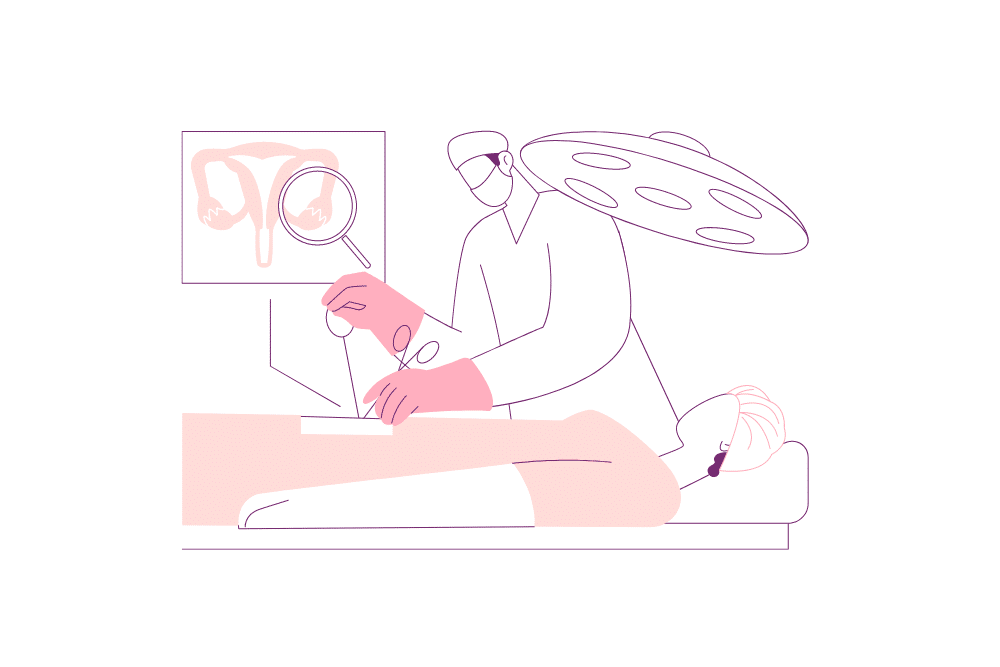Endometriosis, a common yet often misunderstood condition affecting around one in seven Australian women, can be a real game-changer when it comes to daily life. This condition occurs when tissue similar to the lining of the uterus grows outside the womb, causing a range of uncomfortable symptoms.
Imagine waking up to a world where severe pain follows your every move, where fatigue clouds even the simplest of tasks, and where simple joys seem out of reach. That’s the reality for many women living with endometriosis. That’s why seeking treatment for endometriosis is so important for managing endometriosis related pain symptoms and regaining control over health and well-being. It’s time to explore endometriosis treatment in Australia.
Understanding Endometriosis
Endometriosis is a condition where tissue similar to the lining of the uterus grows outside the womb. This rogue tissue can end up on ovaries, fallopian tubes, and other pelvic organs, causing a range of symptoms and ongoing discomfort.
Now, let’s talk about symptoms. Picture this: you’re going about your day when suddenly, a wave of intense pelvic pain hits you out of nowhere. You might also experience heavy periods, painful intercourse, and even fertility issues. These symptoms can vary from person to person, but one thing’s for sure – they can throw a wrench in your plans.
Endometriosis affects approximately 1 in 10 women in Australia, making it a pretty common condition. Yep, you read that right – chances are, someone you know is dealing with endometriosis symptoms right now.
Diagnosis of Endometriosis
When it comes to diagnosing endometriosis, healthcare professionals in Australia have a few tricks up their sleeves. One common method involves a pelvic exam, where your doctor checks for abnormalities in your pelvic region. They might also order imaging tests like ultrasounds or MRIs to get a closer look at what’s going on inside your body.
But here’s the thing: diagnosing endometriosis isn’t always a walk in the park. In fact, it can be downright tricky. See, the symptoms of endometriosis can mimic those of other conditions, making it easy to misdiagnose or overlook. That’s why early detection is key. The sooner you and your doctor can pinpoint the problem, the sooner you can start tackling it head-on.
But let’s be real – getting a diagnosis isn’t always smooth sailing. Many women with endometriosis face a long and winding road filled with misdiagnoses, dismissive healthcare providers, medical gaslighting and frustrating delays. It’s enough to make anyone want to throw in the towel. But don’t lose hope – you’re not alone in this journey, and there are healthcare professionals out there who understand and want to help.
So, if you suspect you may have endometriosis (take our endometriosis quiz to learn more), don’t hesitate to speak up and advocate for yourself. Trust your instincts, and don’t be afraid to seek a second opinion if needed. Remember, the sooner you get a diagnosis, the sooner you can start taking steps towards managing your symptoms and reclaiming your life.

Exploring Endometriosis Treatment Options
When it comes to treating endometriosis in Australia, you’ve got options – and lots of them. Let’s break it down:
Medical Treatments
One popular approach involves hitting endometriosis where it hurts – hormonally speaking, that is. Hormone therapy, such as the combined oral contraceptive pill or hormonal IUDs, can help regulate your menstrual cycle and ease severe symptoms like pelvic pain and heavy bleeding. Pain relief medication can also relieve symptoms of endometriosis.
Surgical Treatment
For some women, surgery might be the way to go. Laparoscopic surgery (a commonly performed keyhole surgery) is often used to diagnose and treat endometriosis. During this minimally invasive procedure, the surgeon will remove any rogue endometrial tissue they find lurking in the pelvic region.
In more severe cases, a hysterectomy – removal of the uterus – or a laparotomy – open surgery for more severe endometriosis bowel surgery if endometriosis has grown in the bowel – may be recommended to provide long-term relief.
Lifestyle Changes and Complementary Therapies
But wait, there’s more! Lifestyle changes can also play a role in managing endometriosis symptoms. From tweaking your diet to incorporating stress-reducing activities like yoga, meditation or mindfulness, there are plenty of natural approaches worth exploring. And let’s not forget about alternative or complementary therapies like traditional Chinese medicine or pelvic floor physiotherapy, which some women find helpful in managing their endometriosis pain.
So, there you have it – a smorgasbord of treatment options for tackling endometriosis in Australia. Whether you opt for medical treatments, surgical interventions, or lifestyle changes, the key is finding what works best for you and your unique situation. Remember, you’re not alone in this journey, and there’s plenty of support and resources out there to help you along the way.
Endometriosis Treatment Guidelines in Australia
When looking into endometriosis treatments, having a roadmap is helpful – and in Australia, healthcare organisations provide just that. Here’s what you need to know:
Overview of Treatment Guidelines
Healthcare organisations in Australia, such as the Royal Australian and New Zealand College of Obstetricians and Gynaecologists (RANZCOG), have developed comprehensive guidelines for managing endometriosis. These guidelines outline best practices for diagnosis, treatment, and ongoing management of the condition, helping to ensure consistency and quality of care across the country.
Recommendations for Healthcare Professionals
For healthcare professionals on the front lines, these guidelines serve as invaluable resources. They provide evidence-based recommendations for diagnosing endometriosis, selecting appropriate treatment options, and monitoring patients’ progress over time. With clear guidance at their fingertips, healthcare providers can feel confident in their ability to support women with endometriosis effectively.
Importance of Individualised Treatment Plans
When it comes to endometriosis, one size does not fit all. That’s why individualised treatment plans are key. Each woman’s experience with endometriosis is unique, and what works for one person may not work for another. By tailoring treatment plans to meet the specific needs and preferences of each patient, healthcare professionals can maximise the chances of success and improve overall quality of life.
So, whether you’re a healthcare professional or someone living with endometriosis, remember that with the guidance of treatment guidelines, the expertise of healthcare professionals, and the power of individualised care, you can navigate the complexities of endometriosis, one step at a time.

Accessing Endometriosis Treatment in Australia
Getting endometriosis treatment can vary depending on where you are. Let’s explore:
Availability of Treatment Options
Endometriosis treatment options are available across different regions of Australia, although the level of access may vary. Major cities typically have a wider range of healthcare facilities and specialists, while rural and remote areas may face challenges in accessing specialised care. However, telehealth services like Youly are becoming increasingly common, offering a convenient way for women in remote areas to connect with healthcare professionals and get treatments delivered to their door.
Costs and Financial Support
Now, let’s talk money. Endometriosis treatment can come with a price tag, from medical appointments to medications and surgical procedures. However, Australia’s public healthcare system, Medicare, helps to offset some of these costs for eligible individuals. Additionally, the pharmaceutical benefits scheme may provide subsidies for medications, including birth control pills offered by Youly. For those facing financial hardship, there are support options available through government programs and charitable organisations.
Importance of Specialised Care and Support
When it comes to managing endometriosis, seeking specialised care is paramount. Gynaecologists and specialists with expertise in treating endometriosis can offer tailored treatment plans and support. Joining support groups or online communities can provide valuable peer support and information-sharing opportunities. And speaking of support, Youly offers convenient access to birth control options, including hormonal therapy, to help manage endometriosis symptoms.
So, whether you’re in the bustling city or the quiet countryside, accessing endometriosis treatment in Australia is possible. By understanding available options, navigating financial support, and seeking specialised care and community, you can take proactive steps towards managing endometriosis and reclaiming your well-being.









